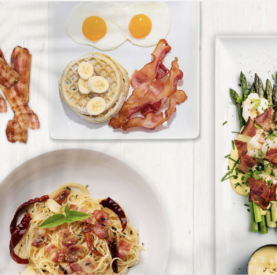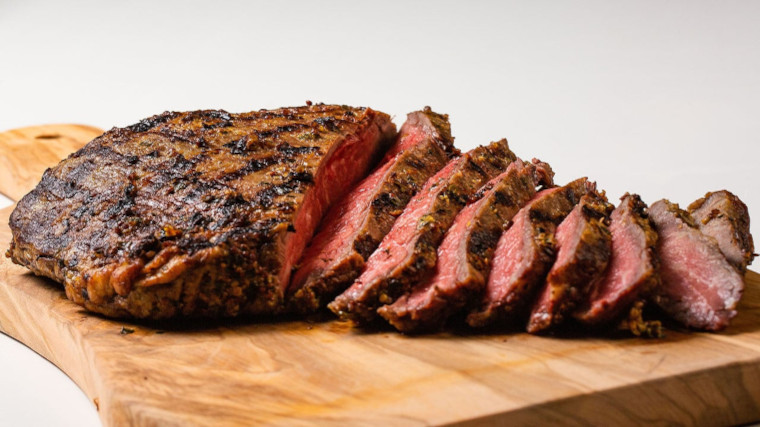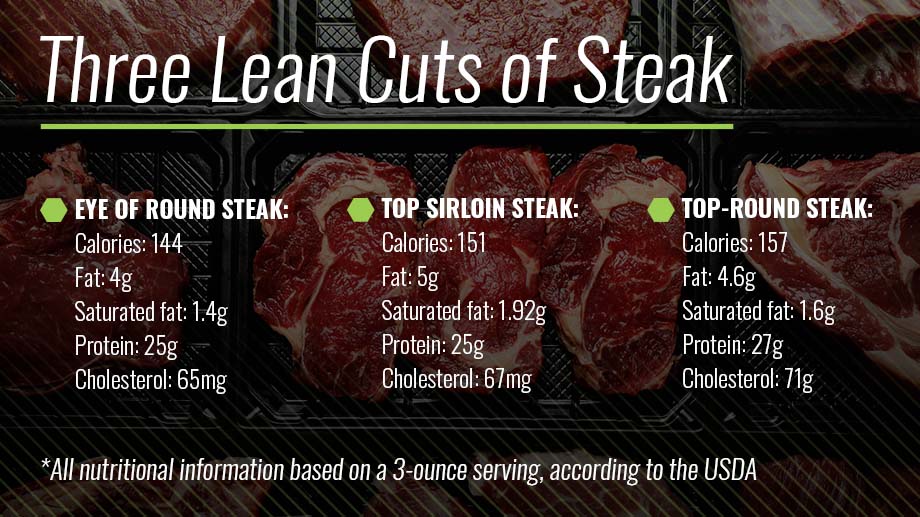You’ve likely ordered a dozen or more steaks at fancy restaurants throughout your life — but have you ever tried to replicate the protein-packed deliciousness in the comfort of your own home? If you haven’t, it’s time to put away the takeout menus and learn how to do it yourself.
Lucky for you (and your taste buds), BarBend has teamed up with ButcherBox to provide you with some important tips and tricks for cooking a picture-perfect steak without breaking the bank.
Whether you want to use your grill, oven, or just a good old-fashioned skillet, you’ll learn how to elevate your steaks from ho-hum to top-notch.
How to Cook the Perfect Steak
- On the Grill
- In the Oven
- On the Stovetop
- How to Tell if Your Steak Is Cooked
- How Much Protein Is in a Steak
- Finding the Leanest Cuts of Steak

Before You Cook
Before you even put meat to flame, there are a few things you need to do first, no matter what cooking method you choose.
Get Your Steak to Room Temperature
First, an hour before you’re ready to start cooking, set your steak out on the counter (away from any curious pets) to get to room temperature. By getting your meat to a uniform temperature, you’ll help ensure it cooks evenly on both sides and throughout the cut.
Pat It Dry
Another key to getting a delicious sear on any piece of meat is to make sure it’s dry before cooking. Once your steak is at room temperature, grab a few paper towels and blot any extra moisture or juice off the top and bottom prior to seasoning. This helps the seasoning stick better and almost guarantees a (frankly irresistible) crust on the outside.
Essential Extras
Wondering which essentials to have on hand to make the steak cooking process easier? Here are a few favorites:
- Sea Salt: This flaky, high-quality salt adds a touch of crunch when your steak receives a proper crust.
- Refined Olive Oil or Canola Oil: Both have a high smoke point, ideal for cooking steak.
- Butter: If it fits into your diet, a tablespoon of butter can go a long way when cooking steak in the oven or on a stovetop.
How to Grill the Perfect Steak
Forget pools and the beach; summer is all about grilled steaks. Here are three tips to help you nail your execution:
Pick the Right Cut
Grilling is the time to grab those thick, picture-perfect steaks you’ve had your eye on, as the grill can handle larger cuts of meat and higher temperatures without issue. You also won’t have to worry about setting your smoke detector off (win-win!) since you’re outside.
Wondering which cuts to use on the grill? Tender options like ribeye, filet mignon, and NY strip steaks are best because they char well on the outside and cook well in intense heat. You can also opt for a Flintstones-worthy London broil if you’re entertaining a group of friends.

The search for high-quality meat ends here, thanks to ButcherBox. Amazing taste. Humanely raised. Delivered to your door. And as a BarBend reader, sign up today and get two packs of bacon for free in every order for the first year of your membership.
Make it Hot
Regardless of the type of grill you’re using, allow it to heat up fully (be patient!) before plopping your steak onto it. If you have a temperature gauge on your grill, wait for it to get between 450°F and 500°F — that’ll be your sweet spot. (Just make sure you rub some olive oil onto the meat first so it doesn’t stick to the grates.)
To check the temperature the old-fashioned way, a good rule of thumb is to simply wave your hand over the heat. If it’s at the correct level of heat, you shouldn’t be able to hold your hand over the flame (don’t touch!) for more than a few seconds.
Once you’ve added your steak to the grill, let it cook for four to six minutes per side to get to medium-rare, depending on your meat’s thickness. (Don’t worry, we delve deeper into cooking times below!) Remember, it’s better to ‘undercook’ your meat, as you can always throw it back on the grill, but overcooking can’t be fixed.
Let Your Steak Rest
After you’ve properly cooked your steak, it’s important to allow your meat to rest for five to 10 minutes before slicing. Your steak will finish cooking during this time, and the juices will seep back into the meat. If you cut into your meat before allowing it to rest, you’ll lose a lot of delicious juice that makes for flavorful steak.
Try It for Yourself

Marinating your steak can jack up the flavor tenfold — it just requires a little forethought. Check out this grilled flank steak recipe that includes the world’s easiest marinade. All you need is grainy mustard, olive oil, and minced chives (don’t forget the steak, obvs) to make it happen.
How to Cook the Perfect Steak in the Oven
A little nervous about cooking a steak on the grill or in an uber-hot cast-iron pan? No worries! Cooking your steak in the oven is an excellent way for beginners to get their feet wet. Check out these three tips to make your steak delish:
Give It a Sear
Before sticking your steak into the oven, you’ll first need to sear the meat on the stovetop with some olive oil, salt, and pepper to get a crust. To do this, pick an oven-safe pan with a heavy bottom and put it on high heat. Once the pan is hot, throw the steaks on for two or three minutes per side.
Preheat Your Oven to 400°F
As you prepare to sear your steaks, remember to preheat your oven to 400°F. Once the steaks are seared, pop them into the oven (still in the oven-safe pan) for an additional five to eight minutes, or until the meat hits the desired level of cooking.
Choose the Right Thickness
If you’re looking to utilize this method, you’ll want to choose a cut of meat that’s thicker than an inch but not so thick that it won’t cook evenly. The most common cut to try here is a top-sirloin steak, but ribeyes and T-bones work, too.
Try It for Yourself

Got all that? Now test it out on your own with this ribeye recipe from ButcherBox. You can add the potatoes and horseradish to really ratchet up the decadence, or just stick with your favorite greens to cut down on the carbs.
P.S: It only takes about 20 minutes and is perfect for an easy weeknight dinner!
How to Cook the Perfect Steak on the Stove
Want to cook a restaurant-quality steak on a stovetop? Here are three easy tips you can use to cook like a pro:
Use a Stainless-Steel or Cast-Iron Pan
When cooking a steak, heat is the key to getting a golden sear. And to do that, a stainless-steel or cast-iron pan is ideal, as both materials can withstand the medium-high heat required for pan-searing a steak. Save your non-stick cookware for less intense tasks like scrambling eggs.
Choose a Quick-Cooking Cut of Meat
If you want to pan-sear your steak without letting it finish in the oven after, choose a quick-cooking cut of meat like a NY strip, ribeye, or sirloin. These cuts tend to be on the thinner side — an inch and a half is the max recommended to ensure the meat cooks evenly and doesn’t require too much time in the pan.
Set It and Forget It (Sort of)
After you’ve laid your steak in your piping hot cast-iron pan, let it cook for about three minutes on each side. You’ll want to resist the urge to fiddle with it and peek at the crust you’ve made. Don’t do it! Your steak will cook more evenly if you let it rest and only touch it when it needs to be flipped. Think three to four minutes per side, and you should be good to go.
Try It for Yourself

Ready to give it a shot? Follow along with this simple pan-roasted ribeye recipe (oh look, a quick-cooking cut of meat!) from ButcherBox. Besides the usual salt and pepper, you’ll need garlic cloves, white wine, fresh thyme, olive oil, butter, and two steaks. Yum!
How to Tell if Your Steak Is Cooked
According to ButcherBox, there’s a literal rule of thumb for seeing if your steak is cooked the way you like it.
You know the soft, fleshy part of your palm right beneath your thumb? That’s basically what a rare steak will feel like. And as you move further away from your thumb and your palm gets firmer toward your wrist mimics the feel of medium-rare, medium, medium-well, and well-done steaks.
If you’re not looking to poke and prod your steaks in the hopes of finding the correct level of doneness, you can simply grab a thermometer and refer to our handy visual guide whenever you want:

How Much Protein Is in a Steak?
Protein is an important component of any person’s diet, particularly for those who are trying to gain muscle mass. And if you’re looking for an easy (and delicious) way to up your protein intake, steak is a good choice.
Though different cuts yield different nutritional profiles, according to the USDA, 100 grams (or about 3.5 ounces) of T-bone steak generally contains:
- Calories: 212
- Protein: 27.3 g
- Total Fat: 11.4 g
- Saturated Fat: 4.68 g
Still trying to figure out how much protein you need? Well, the answer isn’t so cut and dry. While the FDA says folks need at least 50 grams of protein per day for their body to function properly, you’ll likely want to achieve around 1.6 grams of protein per pound of body weight for muscle gain. Here’s a protein calculator to make life even easier:
Protein Intake Calculator
Finding the Leanest Cuts of Steak
Trying to hit your nutritional goals but still want to enjoy a steak? Consider picking up a “lean” cut. According to the USDA, a lean piece of beef has less than 4.5 grams of saturated fat, 10 grams of total fat, and 95 milligrams of cholesterol in a 3.5-ounce serving.
According to information from The Cattlemen’s Beef Board and the USDA’s nutrient database, these are three of the leanest cuts of beef based on a three-ounce serving:

Eye of Round Steak
- Calories: 144
- Fat: 4g
- Saturated Fat: 1.4 g
- Protein: 25 g
- Cholesterol: 65 mg
Top Sirloin Steak
- Calories: 151
- Fat: 5 g
- Saturated Fat: 1.92 g
- Protein: 25 g
- Cholesterol: 67 mg
Top Round Steak
- Calories: 157
- Fat: 4.6 g
- Saturated Fat: 1.6 g
- Protein: 27 g
- Cholesterol: 71 g

The search for high-quality meat ends here, thanks to ButcherBox. Amazing taste. Humanely raised. Delivered to your door. And as a BarBend reader, sign up today and get two packs of bacon for free in every order for the first year of your membership.
Get Cooking!
With a subscription to ButcherBox, you’ll receive 100% grass-fed steaks delivered to your door, and it’s completely tailored to your schedule. From flank steaks and sirloins to ribeyes and porterhouses, ButcherBox offers a range of different cuts. And now that you know how to cook them the right way, all you have to do is put your new skills to good use.
Featured image: ButcherBox